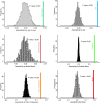Characterizing genetic transmission networks among newly diagnosed HIV-1 infected individuals in eastern China: 2012-2016
- PMID: 35709166
- PMCID: PMC9202869
- DOI: 10.1371/journal.pone.0269973
Characterizing genetic transmission networks among newly diagnosed HIV-1 infected individuals in eastern China: 2012-2016
Abstract
We aimed to elucidate the characteristics of HIV molecular epidemiology and identify transmission hubs in eastern China using genetic transmission network and lineage analyses. HIV-TRACE was used to infer putative relationships. Across the range of epidemiologically-plausible genetic distance (GD) thresholds (0.1-2.0%), a sensitivity analysis was performed to determine the optimal threshold, generating the maximum number of transmission clusters and providing reliable resolution without merging different small clusters into a single large cluster. Characteristics of genetically linked individuals were analyzed using logistic regression. Assortativity (shared characteristics) analysis was performed to infer shared attributes between putative partners. 1,993 persons living with HIV-1 were enrolled. The determined GD thresholds within subtypes CRF07_BC, CRF01_AE, and B were 0.5%, 1.2%, and 1.7%, respectively, and 826 of 1,993 (41.4%) sequences were linked with at least one other sequence, forming 188 transmission clusters of 2-80 sequences. Clustering rates for the main subtypes CRF01_AE, CRF07_BC, and B were 50.9% (523/1027), 34.2% (256/749), and 32.1% (25/78), respectively. Median cluster sizes of these subtypes were 2 (2-52, n = 523), 2 (2-80, n = 256), and 3 (2-6, n = 25), respectively. Subtypes in individuals diagnosed and residing in Hangzhou city (OR = 1.423, 95% CI: 1.168-1.734) and men who have sex with men (MSM) were more likely to cluster. Assortativity analysis revealed individuals were more likely to be genetically linked to individuals from the same age group (AIage = 0.090, P<0.001) and the same area of residency in Zhejiang (AIcity = 0.078, P<0.001). Additionally, students living with HIV were more likely to be linked with students than show a random distribution (AI student = 0.740, P<0.01). These results highlight the importance of Hangzhou City in the regional epidemic and show that MSM comprise the population rapidly transmitting HIV in Zhejiang Province. We also provide a molecular epidemiology framework for improving our understanding of HIV transmission dynamics in eastern China.
Conflict of interest statement
The authors have declared that no competing interests exist.
Figures




Similar articles
-
Molecular genetics and epidemiological characteristics of HIV-1 epidemic strains in various sexual risk behaviour groups in developed Eastern China, 2017-2020.Emerg Microbes Infect. 2022 Dec;11(1):2326-2339. doi: 10.1080/22221751.2022.2119167. Emerg Microbes Infect. 2022. PMID: 36032035 Free PMC article.
-
[Characteristics of subtypes and transmission of HIV-1 infected persons among student MSM in Zhejiang province, 2013-2015].Zhonghua Liu Xing Bing Xue Za Zhi. 2020 Jun 10;41(6):940-945. doi: 10.3760/cma.j.cn112338-20190809-00586. Zhonghua Liu Xing Bing Xue Za Zhi. 2020. PMID: 32564564 Chinese.
-
Genomic Characterization of a Novel HIV-1 Second-Generation Recombinant (CRF01_AE/CRF07_BC) Identified from a Men Who Have Sex with Men (MSM) Patient in Hebei, China.AIDS Res Hum Retroviruses. 2023 Oct;39(10):575-580. doi: 10.1089/AID.2023.0035. Epub 2023 Jul 7. AIDS Res Hum Retroviruses. 2023. PMID: 37335034
-
First Detection of a Cluster Novel HIV-1 Second-Generation Recombinant (CRF01_AE/CRF07_BC) among Men Who Have Sex with Men in Nanjing, Eastern China.Intervirology. 2021;64(2):81-87. doi: 10.1159/000512135. Epub 2021 Feb 11. Intervirology. 2021. PMID: 33571988 Free PMC article.
-
HIV-1 genetic transmission networks among men who have sex with men in Kunming, China.PLoS One. 2018 Apr 26;13(4):e0196548. doi: 10.1371/journal.pone.0196548. eCollection 2018. PLoS One. 2018. PMID: 29698467 Free PMC article.
Cited by
-
AUTO-TUNE: selecting the distance threshold for inferring HIV transmission clusters.Front Bioinform. 2024 Jul 10;4:1400003. doi: 10.3389/fbinf.2024.1400003. eCollection 2024. Front Bioinform. 2024. PMID: 39086842 Free PMC article.
-
HIV-1 drug resistance and genetic transmission network among newly diagnosed people living with HIV/AIDS in Ningbo, China between 2018 and 2021.Virol J. 2023 Oct 13;20(1):233. doi: 10.1186/s12985-023-02193-x. Virol J. 2023. PMID: 37833806 Free PMC article.
-
AUTO-TUNE: SELECTING THE DISTANCE THRESHOLD FOR INFERRING HIV TRANSMISSION CLUSTERS.bioRxiv [Preprint]. 2024 Mar 14:2024.03.11.584522. doi: 10.1101/2024.03.11.584522. bioRxiv. 2024. Update in: Front Bioinform. 2024 Jul 10;4:1400003. doi: 10.3389/fbinf.2024.1400003. PMID: 38559140 Free PMC article. Updated. Preprint.
References
-
- NCAIDS, NCSTD. National AIDS and STD epidemic in November 2016. AIDS and STD in China, 2017(9):675.
-
- National Health and Family Planning Commission of the People’s Republic of China. 2015 China AIDS Response Progress Report, http://www.unaids.org/sites/default/files/country/documents/CHN_narrativ...
-
- Xu Y, Pan X, Yang J, Chen L, Zheng J, Jiang J, et al.. Epidemic characteristics of HIV/AIDS among men who have sex with men in Zhejiang Province in 2004–2013. Chinese Journal of AIDS and STD. 2015,01:37–40. Chinese.

